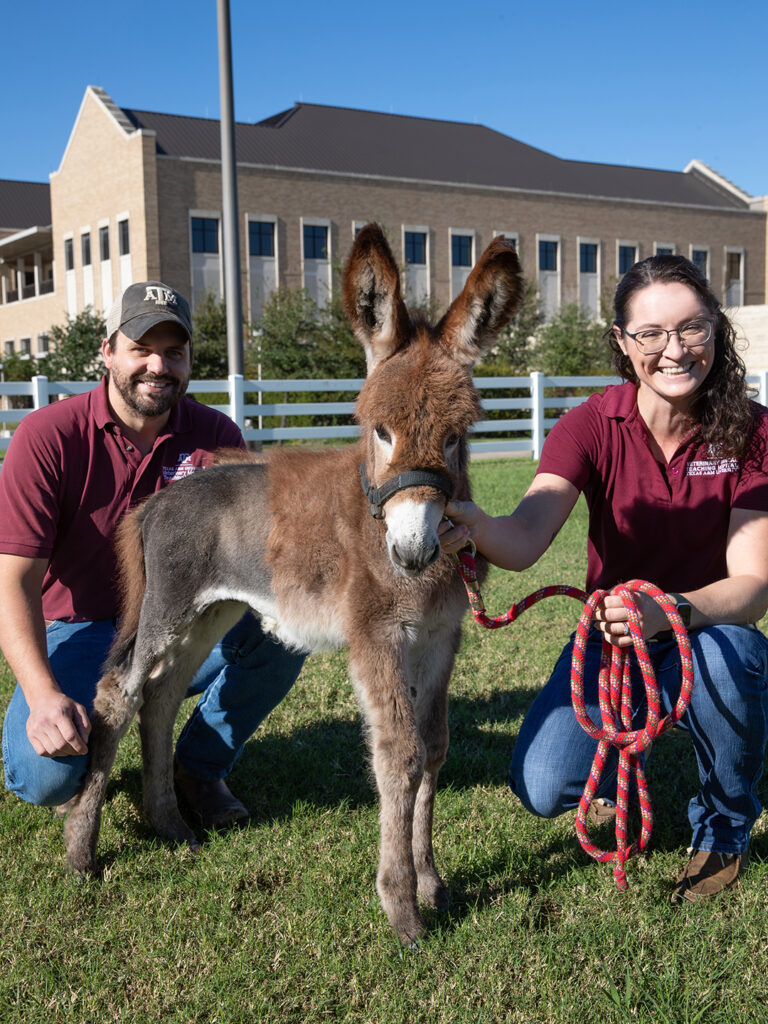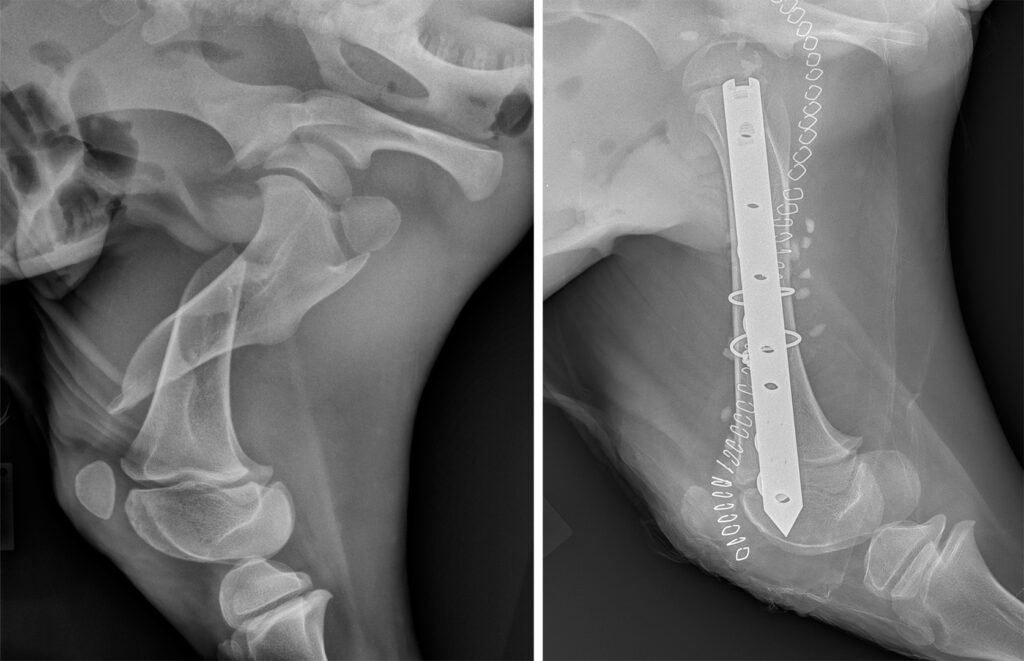Aggie Veterinarians Use Special Implant To Heal Baby Donkey’s Broken Leg

Throughout most of history, horses and other large animals with broken legs were considered a lost cause with no way to come back from such a devastating injury. At the Texas A&M School of Veterinary Medicine & Biomedical Sciences (VMBS), however, broken legs have been fixed in a variety of species thanks to a team of veterinary specialists and innovative surgical techniques and implants.
One recent example is Tink, a standard donkey whose leg was broken when he was only 2 weeks old.
Tink was born at the Blue Moon Sanctuary, a non-profit organization in Georgetown that is home to approximately 120 animals, the majority of which are donkeys.
“About six years ago, I met my first donkey and I just thought they were the most incredible animals,” said Anna Eby, the sanctuary’s owner. “It’s just my personality to need to fix ‘all the things,’ so I started a nonprofit and began rescuing donkeys.”
Tink was inexplicably rejected by his mother soon after birth, so Eby stepped up to hand-raise the foal and soon formed a strong bond with him.
One day soon after, while Eby was feeding some of the other animals, Tink wandered too close to an adult donkey and was kicked. Eby could tell that his leg was most likely broken and rushed the 30-pound foal to her local veterinarian, who recommended that she take him to Texas A&M for treatment.
At the Texas A&M Large Animal Teaching Hospital (LATH), Drs. Jeffery Watkins and Kati Glass have spent their careers developing expertise, techniques, and implants for repairing broken legs in large animals.
Tink’s radiographs showed a long, spiraling fracture of the femur bone in his right hind leg.
Tink went to surgery soon after he arrived at the LATH that night. His procedure began shortly after midnight and finished just before 4 a.m.
Watkins and Glass decided that Tink was a candidate for the use of the intramedullary, interlocking nail implant specifically designed by Watkins for use in fractures of the humerus and femur. This same implant has been used successfully to repair fractures in foals and calves up to 500 pounds, and even in an adult polar bear.

“Tink was quite a small patient for us,” said Glass, a VMBS clinical associate professor in large animal surgery. “Fortunately, the interlocking nail fit perfectly, and just hours after surgery, he was already standing on his leg. We were really happy to see that.”
Tink stayed at the LATH to recover for a little over three weeks, during which time he more than doubled in weight and returned to his “happy foal antics,” according to Glass.
“Young animals tend to heal and form new bone really quickly when we can get the broken pieces back into position and stabilize them with appropriate implants,” Glass said. “Their bone just forms around the implant as they grow.”
Once Tink returned home to Georgetown, he spent several months recovering at a friend’s barn before eventually returning to Blue Moon Sanctuary.
“He’s just been spoiled to death. He doesn’t quite know how to be a donkey because he’s had so much human interaction,” Eby said. “But he’s very interested in his new donkey friends. In fact, he’s kind of a chick magnet.
“His injury was unfortunate, but it couldn’t have turned out better, thanks to Texas A&M,” she said. “My vet told me that there’s literally nowhere else in the world that could have done this procedure for him. I think that’s pretty incredible.”
Today, now that Tink is fully grown, you would never know that he had suffered a broken leg as a foal.
“A lot of people have heard and may even say that if a horse breaks its leg, you can’t fix it. Many times, however, there are options,” Glass said. “While we can’t fix all broken bones yet, we are constantly improving our knowledge, techniques, and implants. Thankfully, because of this, and an owner committed to his care, that old adage was not true for this donkey. It has been exciting to watch Tink grow into a donkey who you’d never know had this issue as a foal.”
###
For more information about the Texas A&M College of Veterinary Medicine & Biomedical Sciences, please visit our website at vetmed.tamu.edu or join us on Facebook, Instagram, and Twitter.
Contact Information: Jennifer Gauntt, Director of VMBS Communications, Texas A&M College of Veterinary Medicine & Biomedical Sciences, jgauntt@cvm.tamu.edu, 979-862-4216